
|
Back to |
| The Front Page |
| The Game |
|
Building the croquet court behind the farm house |
||||||
|
by Gail Arkley with family photos from Gail and Tremaine Arkley and photographer Cheryl Juetten Posted March 23, 2014
|
||||||
|
||||||
When this first-person essay for the short-lived Croquet Magazine first appeared in 1987, there were not as many reference sources available as there are today, so Gail's empathetic anxiety level over how to get started would not be as high today as it was a quarter century ago. As it turned out, Gail and her husband Tremaine covered the bases that are now well publicized in the literature of croquet associations. But the rest of this entertaining report is still as valid. Surely the Arkleys encountered ALL the problems you will encounter when you make the fateful decision to build a court in your back yard. So use this article, as a walk-through checklist of everything that goes wrong but finally turns out right. And after your competition days are over, look at the latter-day photographs for inspiration on recycling the lawn for wedding celebrations and parties of all kinds....
Have you ever taken a stress test? No, not running up and down those little sets of stairs to measure your heart rate. I mean those written scales which rank life events by the amount of stress they produce.
On such a scale, Minor Violation of the Law is the stress-producing event with the least amount of stress, 11 points. Death of Spouse produces the most, at 100 points. However, not every stressful life event appears on the list. Building the Croquet Court is missing. But then it is probably not a Life Event for many people.
It was a Life Event for me. When my husband Tremaine inevitably concluded that it really had to happen (the nearest "real" court being over 250 miles to the north), it didn't seem like that big a deal. Major, yes; but after all, people build swimming pools all the time. These things can surely be done.
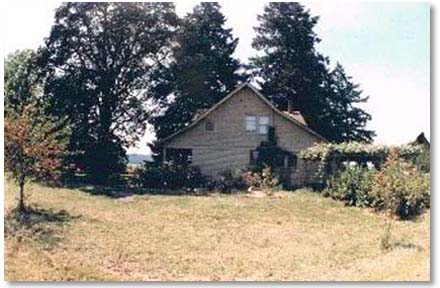
|
The first difference which became apparent was that while there are people anyone can hire to put in a swimming pool, this is not true for croquet courts. Nothing in the Yellow Pages. No do-it-yourself, trade, or even textbooks on the subject. No universally accepted discipline on croquet court construction.
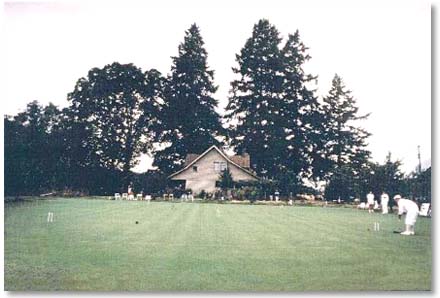
|
Like recipes for chocolate cake: while the products seem much the same, everyone has their own way of doing it, and there are important differences. The hardest part of building a croquet court is figuring out the recipe.
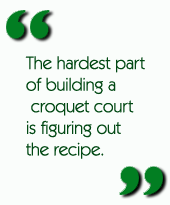 Initial research included the purchase and study of university textbooks on golf court construction, lawn bowling lawn construction, and turf management. (We were lucky to have an agricultural university nearby.) Then came brain-picking telephone calls to university faculty and long conversations with the few individuals who had built, were building, or planned to build a croquet court.
Initial research included the purchase and study of university textbooks on golf court construction, lawn bowling lawn construction, and turf management. (We were lucky to have an agricultural university nearby.) Then came brain-picking telephone calls to university faculty and long conversations with the few individuals who had built, were building, or planned to build a croquet court.
In addition, Tremaine sought and cultivated a circuit of golf course superintendents and other helpful people, including a sod farmer who was ready to roll out the carpet.
After considerable rumination came action. I do not know the strength of will that was required to make the telephone call that brought the first earth-moving equipment, but it must have been considerable. There were different kinds, all monumental. They were driven about in rip-roarin' style by big guys in Can't Bust 'Em overalls. Seated calmly beside each driver was his dog, obviously enjoying the ride.
 It was troubling to have these monsters disruptively bouncing around the pastures by day, but it was even more unnerving to have their stilled and alien presence looming near my home in the evening.
It was troubling to have these monsters disruptively bouncing around the pastures by day, but it was even more unnerving to have their stilled and alien presence looming near my home in the evening.
The most intrusive one was an old lunker with a weathered green, yellow, and rust paint job. Its operator always parked it across my established path from the house to the barn. There was no way I could fool myself that all of this wasn't happening. Every time I went to the barn I had to walk around the damned thing. The tires alone were considerably taller than I am. The business end was a huge lateral blade set aslant. This particular behemoth was a scraper. It scraped away my green rolling sheep pasture, leaving behind an expanse of crumby brown dirt.
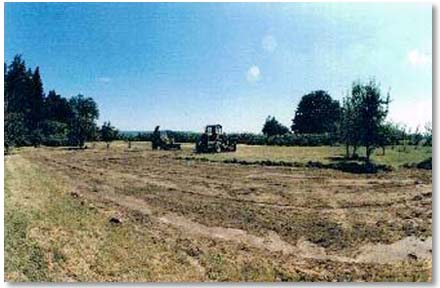
|
Through this phase the earth was moved, shaken, pushed and pulled. Mechanical giants roamed, uprooting or compacting plants, developing ruts, tracks and humps, overturning trees or ripping their bark in passing. Dust churned, powdered, and settled over all. Foliage and flowers lay limply palled under a dry flaky coat of brown. I couldn't keep the floors clean, but still it was better to be inside than out. Inside, the feeling of destruction was not quite so immediate.
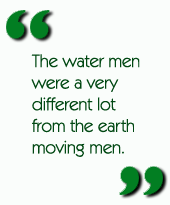 After earth, water. Research in more detail on percolation and drainage, pipes and heads, automatic systems. Then the water men came. They were a very different lot from the earth moving men. Their silver and gray work clothes were pressed and smooth. They themselves were lighter, lither. Even while digging ditches, strewing gravel, laying pipe and installing electronic systems, they were a more contemplative lot. One man would drive up, park his car facing the site, and gaze for ten minutes or so before beginning his tasks.
After earth, water. Research in more detail on percolation and drainage, pipes and heads, automatic systems. Then the water men came. They were a very different lot from the earth moving men. Their silver and gray work clothes were pressed and smooth. They themselves were lighter, lither. Even while digging ditches, strewing gravel, laying pipe and installing electronic systems, they were a more contemplative lot. One man would drive up, park his car facing the site, and gaze for ten minutes or so before beginning his tasks.
It was around this time that I figured out the reason for the occluded atmosphere around the house. Not only dust, stress! At every point, Tremaine had to make decisions, very expensive decisions, based on a review of usually conflicting theories. He began to chronically exhibit a certain clenched-jaw, glazed-eye frown.
To "What is the matter?" he would reply, "Nothing." Of course. How could I possibly respond to issues such as how to insure appropriate drainage through the court without having the court itself drain away. Certainly not with, "Don't worry, honey, I'm sure everything will be alright."
Actually, it might not be alright. There was no way I could supply wifely reassurance. There was no "right" answer equivalent to, "Everyone knows the best chocolate cakes are made with melted chocolate. If I were you I would definitely not use cocoa."
I soon gave up my sympathetic inquiries. There was nothing I could do to help. While he worried about irrevocable choices which if wrong would doom the court, cost thousands, and represent failure, I just worried in general.
 Next, big decisions on sand had to be made. It had not actually occurred to me that the grass would not be growing in dirt. The grass was to grow in washed mason sand. Such is turf science.
Next, big decisions on sand had to be made. It had not actually occurred to me that the grass would not be growing in dirt. The grass was to grow in washed mason sand. Such is turf science.
Washed mason sand is not simply sand. It is sand washed clean of earthly pollutants, and of a certain consistency and fineness. The kind we ordered was not the absolute best, but it was good. We needed a lot. Luckily I was at work when all this was going on. I never actually saw the sand delivered. Apparently the trucks came in a steady relay from the sand and gravel plant.
The earth movers marauded, the water men incised precise ditches, the sand and gravel trucks rolled over the land like the Nazi invasion of Russia. They compacted everything under their weighty wheels. As if their tracks weren't evidence enough of invasion, there were scattered splats of alien gravel, cigarette butts, candy wrappers. But at least I did not have to witness their constant convoy.
The sand was in. The water men slipped back to put up temporary sprinklers to keep it wet and settling. Things were looking pretty good. Although we tracked sand everywhere, I began to relax. But that was to last only a few days. Because, although the stretch of sand appeared dead flat compared to the lovely rolling sheep pasture it had been, it was not level. It had to be level.
By this time, there was a laser leveling technology. However, where we live, people are easier to get than laser levels. Time was getting short. It was now late September. The grass had to be seeded while the ground was still warm enough to insure germination. Otherwise, the seed rots. There had been, had had to be, slack time between each previous phase: slack time for research, telephone calls, discussion, cogitation and anxiety before the next decision to go ahead. We were now out of slack time.
The local contractor assembled a crew of locals. They were to screed the sand. "To screed: to level with a screed." "Screed: a leveling device." Using boards, they divided the court into sections. Then they used boards to pull, pull, pull the heavy wet sand in each section until it was finally level.
I had the bad luck to be home sick in bed during this. I have never seen seven or eight grown men do anything so slowly. Shirts off, they toiled ponderously. I saw only their sweaty backs from my upstairs window. Tensions thickened as Tremaine tried to balance the duties of his job with the duty of watching over his investment. He finally got out there and screeded with them. It was a tense, tedious, and dirty time. It was not a time to ask questions or make comments. The frown never left Tremaine's face.
Finally and at long last, they were done and gone. The court was level and the court was smooth. It was also as soft as a sandy beach. I kept the dog in sight and under voice control at all times. Nonetheless, I was aghast one early morning to discover a large paw-shaped hole marring the smooth expanse. We blamed the dog. Who else had feet like that? From then on she was on the leash.
Compliant, she turned her plaintive brown eyes to me questioningly as I curtailed her freedom. Still another large paw hole appeared. This time, though, I witnessed my smallish cat bounding across a corner of the court leaving a disproportionately large footprint. The cats were the culprits.
Earlier, we had been advised that we would have to get rid of our two cats, but we had not even considered it. Now, we removed the leash from the dog, and put the cats in the house. They were much too entertaining and lovable to "get rid of," but I did not realize what we were in for when I imprisoned them. They had an indeterminate sentence until the court was no longer so impressionable.
 These are outside cats. They like being inside, but only in proper balance with outside. After the first few times that sitting by the door brought no response from us, they realized something was wrong. Sitting evolved to standing and pawing. And meowing. Then pacing and headlong dashes every time a door was opened.
These are outside cats. They like being inside, but only in proper balance with outside. After the first few times that sitting by the door brought no response from us, they realized something was wrong. Sitting evolved to standing and pawing. And meowing. Then pacing and headlong dashes every time a door was opened.
To their credit, they did not get personally vengeful and do nasty things like pee in corners. But they were very upset. By the end of the first week we were all nervous. Peace came only when they slept. They seemed now to conclude there was no hope, and slept almost continuously.
Meanwhile, the race against the calendar and the weather continued. We had to get the court seeded in time to germinate. Here again, one doesn't just look in the Yellow Pages for "seed" and "Croquet Court." By chance, our Willamette Valley in Oregon happens to be one of the world's leading producers of grass seed. Despite the fact that it is all distributed wholesale and that the annual seed production is sold years in advance, Tremaine had secured enough Penneagle Bentgrass to seed the court.
 But how to seed, who? The network of golf course superintendents yielded a resource. One day I returned home from work to find Tremaine sweaty, sandy, and jubilant. "We seeded the court!"
But how to seed, who? The network of golf course superintendents yielded a resource. One day I returned home from work to find Tremaine sweaty, sandy, and jubilant. "We seeded the court!"
Sure enough, ever so faintly on the court were the wheel marks of the seeder, a smallish, well-worn implement like an orange bin on wheels.
Then we waited. The October days were warm and sunny, the nights cool. The water system sprayed faithfully. The cats slept on.
Then, one afternoon, returning home, we noticed. The court glowed with the faintest haze of green. "It's up!" I shouted joyfully. By now, I was thoroughly entangled in the whole process. What if it hadn't come up? Was there enough seed left to do it again? Could we finagle more? How much would it cost? Was there still time for germination before the weather turned? If not, how could we protect the surface over the winter? Would we have to re-screed? Who could we get to do it? When should it be done? How much would that cost? And what in the world would we do with the cats all winter?
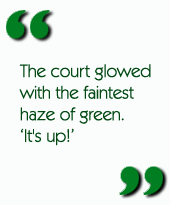 But it was up, and amazingly evenly over the expanse. The golf course superintendent had warned us to expect patchy germination and eventual reseeding. This was not to be. The green glow covered all. Almost immediately the weather turned chilly and the rains came. The green-brown expanse got greener and greener.
But it was up, and amazingly evenly over the expanse. The golf course superintendent had warned us to expect patchy germination and eventual reseeding. This was not to be. The green glow covered all. Almost immediately the weather turned chilly and the rains came. The green-brown expanse got greener and greener.
In about a week we decided to let the cats out before their spirits were completely broken. I felt like a prison warden as I opened the door. Poor creatures! Now, there were no headlong dashes to freedom, but a tentative exiting. "Am I really free? What is freedom, anyway?" They must have regained their memories; they were gone for several days.
It seems over with, doesn't it? Building the croquet court, that is. That, at least, was what I thought as we settled into fall and winter. The grass grew greener, thicker. The court seemed perfect to me. But every time we walked on it, especially if someone else was along, Tremaine would say, "It's kind of soft, isn't it? It isn't very hard, is it? It's kind of soft." And so on. It became a conversational theme.
Fortunately, as the grass roots took hold, the court became firmer. Slowly the anxiety of the perpetually soft court faded. It was replaced with the stress of worrying about the first mowing.
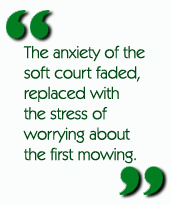 The mowing had to be done with a special walk-behind greens mower weighing over 200 pounds, propelled on a drum instead of wheels, and resembling a floor sander. And you know what kind of gouges those floor sanders can make! Just imagine what such a lawnmower could do to a semi soft, newly planted croquet court! The greens mower gleamed in the barn, gathering dust. Cold weather increased the dormancy of the grass, delaying the dreaded day.
The mowing had to be done with a special walk-behind greens mower weighing over 200 pounds, propelled on a drum instead of wheels, and resembling a floor sander. And you know what kind of gouges those floor sanders can make! Just imagine what such a lawnmower could do to a semi soft, newly planted croquet court! The greens mower gleamed in the barn, gathering dust. Cold weather increased the dormancy of the grass, delaying the dreaded day.
It had to come. On Thanksgiving, with unknown levels of courage, Tremaine propelled the greens mower from the barn to the court, removed the wheels used for transit, and began. His movements behind the heavy, rapidly rolling machine were jerky and uncertain. I felt hysteria as he stepped along erratically behind it, Chaplinesque, each turn exaggerated.
Despite his quickened pace, it seemed to take forever. It was probably about an hour and a half. Not a whole lot of damage was done during that first mowing, but neither of us enjoyed it.
The croquet court was looking beautiful, getting firmer, and being mowed with increasing skill. With spring came increased growth and maintenance debates. How short should it be cut? Three sixteenths? Quarter inch? Shorter? Longer?
 What about diseases? Each unidentified spot on the court sent us to the turf management text chapter on diseases. Like medical students, we inevitably diagnosed the worst.
What about diseases? Each unidentified spot on the court sent us to the turf management text chapter on diseases. Like medical students, we inevitably diagnosed the worst.
We had several diagnoses confirmed. Starlings waddling over the court meant some type of worm. Rings in the grass meant fusarium--common and treatable. Again the research and discourse. Vermicides, fungicides, and fertilizers come in myriad variety to match specific needs. And so it went. What kind? In what form? How much? How often? When to water? How much? How often?
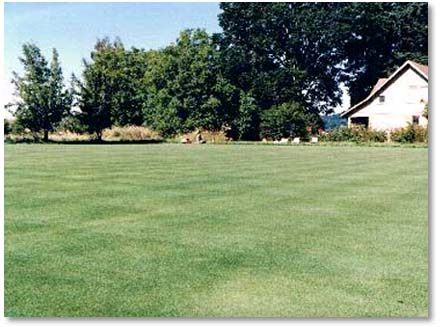
|
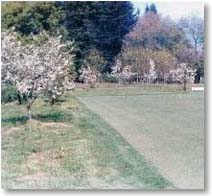
|
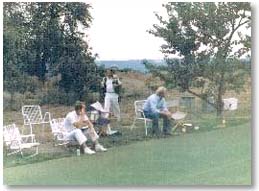
|
If you come from the south and west and take a certain road, you will pass the Edsel farm. Parked in row upon weed-smothered row, behind and around a weathered farmhouse and metal sheds, sit ranks of mossy Edsels.
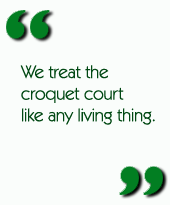 Making your way over the hill, you'll go by the Barking Dog Farm. Chained in front of an equipment shed by the road, a dog barks in perpetual warning at every passing car.
Making your way over the hill, you'll go by the Barking Dog Farm. Chained in front of an equipment shed by the road, a dog barks in perpetual warning at every passing car.
Up over the next hill, coming into Buena Vista, on the right you'll see Mr. Nicely's Draft Horse Farm. The majestic horses are beautiful, and their foals especially so. Once in a while Mr. Nicely harnesses them to a buckboard and clatters around the roads on tireless wheels.
At the top of the hill on your left is the Giant Bear Statue, a larger-than-life representation of a grizzly, chain saw carved from a tree trunk. As you follow the road around, take a brief detour down to the Willamette River to see the Buena Vista Ferry, one of three river ferries remaining in the state.
Pass through Buena Vista and down the hill. If you take the first right, you'll see another fantasy. You might not recognize it at first for what it is; a monstrous chair made from an equally monstrous tree stump.
There are some interesting crops along the way, too: nursery stock like armies of sticks in rows, and the only nectarine orchard in Oregon. Watch for the croquet court on the corner, just before you get back on the main road.
On the way into Independence, slow down as you go by a certain small property. The retired couple who live there are doing everything they ever wanted to do, and on one long narrow roadside acre. First she planted herbs, flowers, and grapes, tending her garden at daybreak. Next came the small solar greenhouse, unfortunately situated in the shade of a magnificent Douglas fir. Inevitably the fir was felled, its huge body hacked brutally into firewood, its stump burned hollow and planted with petunias. This allowed space for the addition of a room and a deck to the small house.
Then, one fall, a large earth mover scraped up and down, around and around, hollowing out an oblong shallow basin south of the house. I deduced what it was when I saw her filling it with a garden hose: a pond. Soon there was a bridge to an island, two boats, and ducks. Then came perimeter plantings, a sprinkler system, a little red barn, a pitcher pump, and wind sock....They're now drilling another well. We await further developments.
The next house is about the same 1940's vintage, but unremarkable except for the full set of drums standing in the uncurtained window and the loyal German Shepherd who has guarded from the same spot for years. Nothing much 'til Independence unless you count the sheep barn with a billboard, over the door reading MAIN ENTRANCE.
Once you get to town be sure to see the historic mural, the old caboose, the pioneer covered wagon in the glass case....
POSTSCRIPT:
Gail writes, "By 2014 my husband has given up competitive croquet and the court has long since been recycled to more easily sustainable rural uses. It remains an open space with orchards on two sides, a line of trees and hedge on another side, and the house, yard and gardens on the final side, the same as before, except of course grown after all these years. Tremaine re seeds the court itself every few years with low growing rye from a local seed company. Like any lawn it becomes rustic as the years go by. We have our own parties, and friends and relatives have asked to hold various ceremonies here, including weddings. For a party, there are usually lawn games such as backyard croquet and petanque."
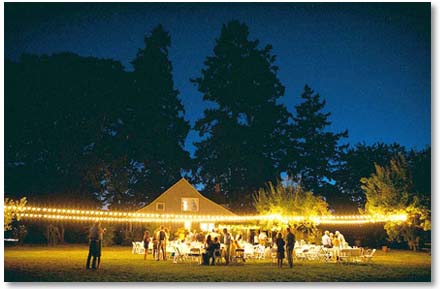
|
| In 2014, Arkley croquet court is recycled for many uses at all hours of the day and night. At midday, lawn games sometimes include backyard croquet as spectators loll in the shade of the fruit trees. At dusk, tenting shelters food and drink service. After a wedding in the evening, the party continues late into the night, profiled by the Arkley farmhouse and the ancient fir trees towering above it. Photo by Cheryl Juetten. |